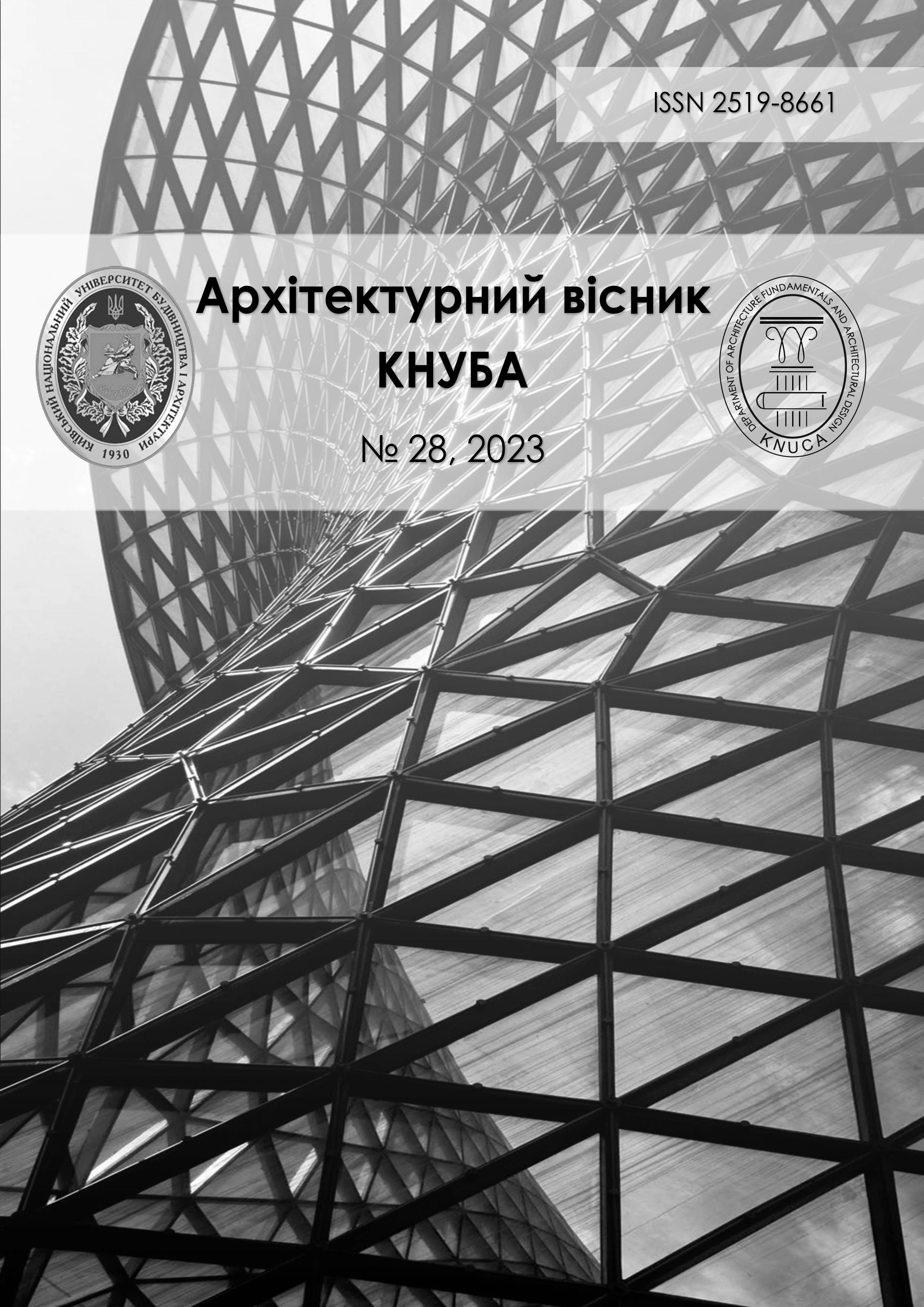КРИТЕРІЇ КЛАСИФІКАЦІЇ ПІДЗЕМНИХ НАУКОВО-ДОСЛІДНИХ КОМПЛЕКСІВ
DOI:
https://doi.org/10.32347/2519-8661.2023.28.111-117Ключові слова:
підземна урбаністика, науково-дослідні комплекси, класифікація, підземні науково-дослідні комплексиАнотація
Стаття присвячена класифікації підземних науково-дослідних комплексів, котрі за останні десятки років стали важливою інфраструктурою для проведення досліджень в галузях фізики, астрофізики, геології та біології. Окреслені основні переваги підземних комплексів над науково-дослідними комплексами, що розміщені на поверхні. Проаналізовані праці вітчизняних та закордонних вчених свідчать про потребу подальшого дослідження даної теми, оскільки опрацьований матеріал є дотичним до теми дослідження та не розкриває її аспекти в повній мірі. У статті розглянуто основні критерії класифікації, що налічують 5 основних категорій: інженерно-геологічні характеристики; цільове призначення; технічні характеристики; архітектурно-планувальні ознаки; групи ризиків. Деякі з категорій класифікації розділені на підкатегорії. Інженерно-геологічні характеристики запропоновано розділити на критерії розташування за межами міського простору та за типом доступу до комплексу. Категорія технічних характеристик представлена трьома критеріями: кількістю основних залів, глибиною, об’ємом комплексу. За архітектурно-планувальними ознаками підземні науково-дослідні комплекси розділені за композиційно-просторовою схемою на поверхні та під землею, за кількістю рівнів. Класифікація ґрунтується на аналізі світового досвіду проектування глибокопідземних лабораторій, що знаходяться в юрисдикції CERN, систематизації даних про них отриманих зі звітів CERN, котрі знаходяться у відкритому доступі. Представлена в статті класифікація створена з метою поглиблення знань та розуміння організації підземних науково-дослідних комплексів, в тому числі їх містобудівної, об’ємно-просторової та функціонально-планувальної структури. Запропонована класифікаційна система може слугувати для подальшої розробки рекомендації щодо проектування даного типу комплексів.
Посилання
Бібліографія
Votano, Lucia. "Underground Laboratories." PATRAS 2010 (2010): 176-179.
Admiraal, H., & Cornaro, A. Underground Spaces Unveiled
Kenneth B. Labs. (1975). The Architectural Use of Underground Space: Issues & Applications (Doctoral dissertation, Washington Univ
Reynolds, E. (2019). Underground urbanism. Routledge
Wright, A. (2012). Underground Architecture: connections between ground-level public space and below-ground buildings
Гайко, Г. І. (2019). Комплекс пріоритетних завдань для системного розвитку підземної урбаністики. In Форум гірників–2019: матеріали міжнар. наук.-техн. конф (pp. 26-27).
Панкратова, Н. Д., Г. І. Гайко, and І. О. Савченко. "Визначення пріоритетів розвитку підземної інфраструктури мегаполісів на основі системної методології." (2021). DOI: https://doi.org/10.20535/2707-2096.6.2021.241820
Von der Tann, Loretta, et al. "Systems approaches to urban underground space planning and management–A review." Underground Space 5.2 (2020): 144-166 DOI: 10.1016/j.undsp.2019.03.003
Sterling, Raymond, and Priscilla Nelson. "City resiliency and underground space use." Advances in Underground Space Development (2013): 43-55.
Admiraal, H. (Ed.). (2015). Think deep: planning, development and use of underground spaces in cities. ISOCARP
Stones, Peter, and Tan Yoong Heng. "Underground space development key planning factors." Procedia Engineering 165 (2016): 343-354 DOI: 10.1016/j.proeng.2016.11.709
Bettini, A. "Underground laboratories." Nuclear Instruments and Methods in Physics Research Section A Accelerators Spectrometers Detectors and Associated Equipment 626(8) January, 2011. DOI: https://doi.org/10.1016/j.nima.2010.05.017
Bettini, Alessandro. "New underground laboratories: Europe, Asia and the Americas." Physics of the Dark Universe 4 (2014): 36-40 DOI: https://doi.org/10.1016/j.dark.2014.05.006
Ianni, Aldo. "Considerations on Underground Laboratories." Journal of Physics: Conference Series. Vol. 1342. No. 1. IOP Publishing, 2020 DOI: 10.1088/1742-6596/1342/1/012003
Coccia, E. "Underground laboratories in Europe." Journal of Physics: Conference Series. Vol. 39. No. 1. IOP Publishing, 2006 DOI 10.1088/1742-6596/39/1/134 DOI: 10.1088/1742-6596/39/1/134
Pytel, Witold, et al. "Universal approach for risk identification and evaluation in underground facilities." (2020) c. 173-174. DOI: https://doi.org/10.37190/MSC202712
References
Votano, Lucia. "Underground Laboratories." PATRAS 2010 (2010): 176-179. (in English)
Admiraal, H., & Cornaro, A. Underground Spaces Unveiled (in English)
Kenneth B. Labs. (1975). The Architectural Use of Underground Space: Issues & Applications (Doctoral dissertation, Washington Univ (in English)
Reynolds, E. (2019). Underground urbanism. Routledge (in English)
Wright, A. (2012). Underground Architecture: connections between ground-level public space and below-ground buildings (in English)
Haiko, H. I. (2019). Kompleks priorytetnykh zavdan dlia systemnoho rozvytku pidzemnoi urbanistyky. In Forum hirnykiv–2019: materialy mizhnar. nauk.-tekhn. konf (pp. 26-27). (in Ukrainian)
Pankratova, N. D., H. I. Haiko, and I. O. Savchenko. "Vyznachennia priorytetiv rozvytku pidzemnoi infrastruktury mehapolisiv na osnovi systemnoi metodolohii." (2021). DOI: https://doi.org/10.20535/2707-2096.6.2021.241820 (in Ukrainian)
Von der Tann, Loretta, et al. "Systems approaches to urban underground space planning and management–A review." Underground Space 5.2 (2020): 144-166 DOI: 10.1016/j.undsp.2019.03.003 (in English)
Sterling, Raymond, and Priscilla Nelson. "City resiliency and underground space use." Advances in Underground Space Development (2013): 43-55. (in English)
Admiraal, H. (Ed.). (2015). Think deep: planning, development and use of underground spaces in cities. ISOCARP (in English)
Stones, Peter, and Tan Yoong Heng. "Underground space development key planning factors." Procedia Engineering 165 (2016): 343-354 DOI: 10.1016/j.proeng.2016.11.709 (in English)
Bettini, A. "Underground laboratories." Nuclear Instruments and Methods in Physics Research Section A Accelerators Spectrometers Detectors and Associated Equipment 626(8) January, 2011. DOI: https://doi.org/10.1016/j.nima.2010.05.017 (in English)
Bettini, Alessandro. "New underground laboratories: Europe, Asia and the Americas." Physics of the Dark Universe 4 (2014): 36-40 DOI: https://doi.org/10.1016/j.dark.2014.05.006 (in English)
Ianni, Aldo. "Considerations on Underground Laboratories." Journal of Physics: Conference Series. Vol. 1342. No. 1. IOP Publishing, 2020 DOI: 10.1088/1742-6596/1342/1/012003 (in English)
Coccia, E. "Underground laboratories in Europe." Journal of Physics: Conference Series. Vol. 39. No. 1. IOP Publishing, 2006 DOI 10.1088/1742-6596/39/1/134 DOI: 10.1088/1742-6596/39/1/134 (in English)
Pytel, Witold, et al. "Universal approach for risk identification and evaluation in underground facilities." (2020) c. 173-174. DOI: https://doi.org/10.37190/MSC202712 (in English)
##submission.downloads##
Опубліковано
Номер
Розділ
Ліцензія
Авторське право (c) 2024 Valeriia Salo

Ця робота ліцензується відповідно до Creative Commons Attribution 4.0 International License.


